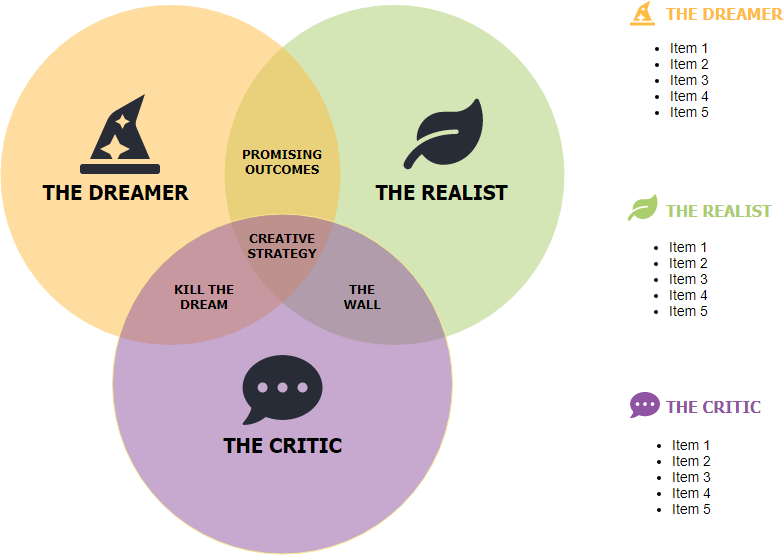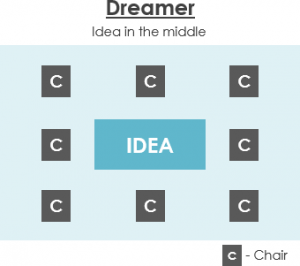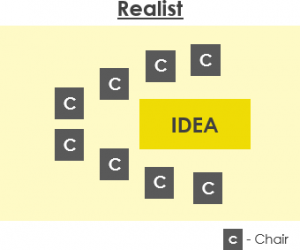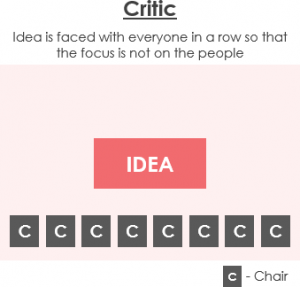If I told you that mice are cute, lions can sing, and old houses can fly, all of which have a market value of 100 billion US dollars, you may dismiss them. Walt Disney has become a name in popular entertainment that needs no introduction.
The Disney Creativity Strategy (also known as Disney Brainstorming Method or Disney Creativity Method) that created this 100 billion kingdom was proposed by Robert Dilts in 1994. It has provided an effective roadmap for the incubation of many products and projects for thirty years. The Disney strategy includes three steps to help individuals and teams identify project goals, clear paths, and avoid risks as shown in the Venn diagram below.

Edit this Disney’s Creative Strategy template
“Creativity as a total process involves the coordination of these three subprocesses: dreamer, realist, and critic. A dreamer without a realist cannot turn ideas into tangible expressions. A critic and a dreamer without a realist just become stuck in perpetual conflict. The dreamer and a realist might create things, but they might not achieve a high degree of quality without a critic. The critic helps to evaluate and refine the products of creativity.”
Robert B. Dilts, Strategies of Genius: Volume 1
Disney’s Creativity Thinking Process
Disney’s strategy works owing to the strict separation of three roles — to generate ideas, evaluate ideas, construct and critique a plan of action structured in three thinking styles: dreamers, realizers, and critics. Disney’s Creativity Thinking Process bridges the gap between imagination and reality.
The creative process unlocks the mind’s capabilities to dream and form unexpected ideas and solutions for existing problems. However, these solutions may not be applicable in reality and may not be applied as a strategic plan. Therefore, one of the advantages of Disney’s creative strategy method is balancing both dream and reality in order to build a viable layout.
The three thinking styles are – dreamers, realizers, and critics.
- In the first thinking style, the group thinks as dreamers to brainstorm ideal solutions. They use divergent thinking to conceive creative and radical ideas.
- In the next mode, the group adopts a realizer viewpoint. They act as pragmatic realists and use convergent thinking to review the ideas left by the dreamers. They select the best idea and construct a plan for it.
- The final viewpoint is that of critics. They review the plan made by the realists in order to identify weaknesses, obstacles or risks. They seek to improve the plan.

DREAMER – The dreamer’s wild imagination opens the door to creativity. Many people say that I am not creative. In fact, more often, we are restricted by ourselves or the environment.
How-To be a Dreamer? – What dreamers care about?
- “Give yourself 15 minutes to freely describe your dream time”
- If everything is possible, without any restrictions, without any pressure, how do you describe your vision, your career, your business, your life, your next step?
- What will give you passion and what will make you feel happy?
- If your dreams come true, what will you see and what will you gain? Try to imagine in your mind how your dreams come true.
Answer the above questions as carefully as possible. At this stage, you do not need to consider whether it is feasible or not. The most important thing is to freely describe your imagination. Don’t rush to deny yourself.
REALIST – Based on the dreamers, the practitioners continue to think about how to implement them concretely and formulate actual implementation plans.
How to be a realist? – The doers focus on how to do it.
- How do “20 minutes to make a plan” come true? When and where? Who is responsible for implementation?
- How will I take action? How to make a plan and what are the relevant steps to success?
- What needs to be done today, tomorrow, next week, and next month?
- What resources do I have? How to make good use of these resources?
- With whom? Where can I get assistance?
- How to get more resources and a wider platform?
Simulation experience step by step towards success. Establish important points of the plan. Doers believe that the ideals portrayed by dreamers can be realized.
CRITIC – The critic reviews all the ideas and tries to punch holes in them by playing the devil’s advocate.
How to be a Critic?
- Five minutes of time to improve the program,”
- How do I really feel about it? Is this the best I can do?
- What can make it better? Does this make sense?
- How does it look to a customer? A client? An expert? A user?
- Is it worth to work on this idea? Can I improve it?
Critics can maximize the plan. Let us move forward more firmly. Critics are concerned about why.
How to Create Disney’s Creativity Strategy in Team Afford?
Disney used the same three strategies to keep his staff coordinated in their thinking on a particular project. He moved the ideas around three rooms. Each room had a different function.
- Room 1 was the Dreamer Room – Every dream, creative idea or hunch was developed without limitation. No criticism was used in this room.

- Room 2 was the realist room – Here people would consider what would be required to make the dream be turned in to reality. In Disney’s case this was where the storyboard for the film would be developed. How could that idea be made possible?

- 3 was the critic room – The strengths and weaknesses of the idea are looked at in detail here. It’s the idea that was criticized, NOT the person who came up with the idea.

Conclusion
The Disney Creativity Strategy is an excellent technique to do on your own. It is also a great in coaching or in team development. It involved exploring ideas using three different thinking stages. As a result of the three main stages above in Disney’s Creative Strategy, the team reaches a solid creative idea with an action plan to apply it.
Each stage represents a style of thinking and they should be applied in the following sequence as below:
- Dreamers concentrate on the creative aspect and sharing creative ideas and solutions.
- Realists focus on reality and how to turn the idea into an action plan.
- Critics aim to identify the shortcomings in the idea and overcome it in a final plan or simply put everything away.
If you want to be successful in the creative process, you need to have a mix of 3 things: the ability to dream big; the ability to be pragmatic; and the ability to be critical of what is produced. Thus, you need all three roles filled for true, meaningful creativity.
- Without the Dreamers, the Realists has nothing to do.
- Without the Realists, the Dreamers’ ideas never leave their heads.
- Without the Critics, the Dreamers and Realists’ work will be half-baked and unpolished.